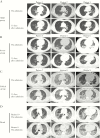Serum Iron Level as a Potential Predictor of Coronavirus Disease 2019 Severity and Mortality: A Retrospective Study
- PMID: 32661499
- PMCID: PMC7337740
- DOI: 10.1093/ofid/ofaa250
Serum Iron Level as a Potential Predictor of Coronavirus Disease 2019 Severity and Mortality: A Retrospective Study
Abstract
Background: Various types of pulmonary diseases are associated with iron deficiency. However, information on iron status in coronavirus disease 2019 (COVID-19) is scarce.
Methods: This study included 50 hospitalized patients with confirmed COVID-19. The role of serum iron in predicting severity and mortality of COVID-19 was evaluated.
Results: The most common symptoms of COVID-19 patients in this study were cough (82%), fever (64%), and chest distress (42%). Of the 50 patients, 45 (90%) patients had abnormally low serum iron levels (<7.8 μmol/L). The severity of COVID-19 was negatively correlated with serum iron levels before and after treatment and was positively correlated with C-reactive protein, serum amyloid A, D-dimer, lactate dehydrogenase, urea nitrogen, and myoglobin levels. Decreased serum iron level could predict the transition of COVID-19 from mild to severe and critical illness. Seven (53.8%) patients with a lower serum iron level after treatment in the critical group had died. There was a significant difference in posttreatment serum iron levels between COVID-19 survivors and nonsurvivors.
Conclusions: Serum iron deficiency was detected in the patients with COVID-19. The severity and mortality of the disease was closely correlated with serum iron levels. Low serum iron concentration was an independent risk factor for death in COVID-19 patients.
Keywords: coronavirus disease 2019; mortality; prediction; serum iron; severity.
© The Author(s) 2020. Published by Oxford University Press on behalf of Infectious Diseases Society of America.
Figures



References
-
- Wu Z, McGoogan JM. Characteristics of and important lessons from the coronavirus disease 2019 (COVID-19) outbreak in China: summary of a report of 72314 cases from the Chinese Center for Disease Control and Prevention. JAMA 2020;323:1239–42. - PubMed
-
- Mahase E. Coronavirus covid-19 has killed more people than SARS and MERS combined, despite lower case fatality rate. BMJ 2020; 368:m641. - PubMed
LinkOut - more resources
Full Text Sources
Other Literature Sources
Research Materials

